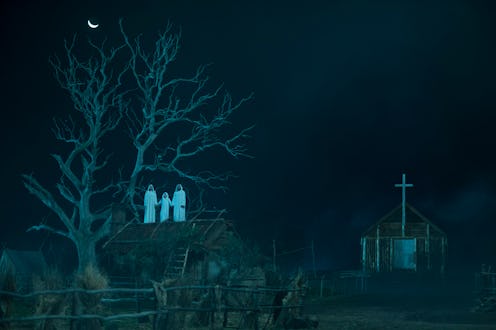
Viewers weren't quite sure what to think when the Season 2 premiere of The Leftovers opened with a wordless sequence featuring a cavewoman, her newborn baby, and a deadly rattlesnake. If you're still scratching your head over that, then you were probably equally flummoxed by the opening of the Leftovers Season 3 premiere, "The Book Of Kevin," which featured a similar silent scene disconnected from the main plot of the series — which is perhaps unsurprising, since both premieres were directed by the same person: Mimi Leder, who is also an executive producer on the series.
At least this time we didn't have to travel all the way back to a prehistoric era; Season 3's prologue took place in the 1840s, as an unnamed woman, her husband, and their son prepared for some apocalyptic event — the rapture? the second coming of Christ? — at the behest of their preacher. When the day came (Jan. 21, 1844), after having given away most of their earthly goods, the family climbed to the roof of their house to await the end times. But they never came.
The family climbed down from their roof (to the ridicule of the town's populace) and went about their daily lives, until the preacher came up with another date. Once more, they climbed up… and one more they climbed down, disappointed. Although the woman's faith remained unshaken, she found herself abandoned by her husband and son. So, on the third date the preacher provided, she climbed up once more, this time alone; and though she waited all night through the pouring rain, she stood there the next day as disappointed as ever.
The whole sequence was underscored with the Christian song "I Wish We'd All Been Ready," each chorus ending with the chilling phrase, "You've been left behind." As the woman goes to lie down in the church with her fellow disappointed parishioners, the scene segues back to modern times — and to the Guilty Remnant, still shacked up in the Miracle National Park visitor center.
What does it all mean? In fairness, this prologue isn't quite as inscrutable as Season 2's cavewoman sequence. The cult-like worshippers are based on the real-life Millerites who, under the leadership of William Miller, truly believed that Jesus would return in 1844. These precursors to Adventism were based in upstate New York (like Season 1's Mapleton) and the failure of Christ to arrive on the designated date was deemed the Great Disappointment (eerily reminiscent of the Sudden Departure). In The Leftovers' version of the story, they even wear ghostly white robes much like the Guilty Remnants' all-white garb.
Despite these answers, there's still a lot that's cryptic about this sequence. What exactly does it mean, and how does it tie into the season as a whole? If it follow the pattern laid out by Season 2's prologue, it won't ever be addressed again before the end of the show — which means any solution to the mystery must be contained within the sequence itself. Thankfully, director Mimi Leder is here to answer at least some of our questions.
"For me, the power of that sequence is that these people, this cult in the 1840s was a precursor to the Guilty Remnant," Leder tells Bustle in an interview. "[The sequence] talks about the cycle of life and people's desires either to move on, or to live on, or to move to another place, people looking for answers. It says so much about these Millerites that they wanted to Depart and meet their loved ones in heaven. They wanted to find peace… and in the end they didn't, and they were the Leftovers of their time. In that way, that's the connection of that sequence to where we are present day, where we left off Season 2 starting Season 3. It is confounding," she admits.
It was also very difficult to shoot, she says. "The Millerite sequence was very challenging to film; in the mud and the rain, it was cold, we built that set, I had an actress in a robe who was wet for hours. Oh my god, it was so challenging. And challenging to shoot a story without words, and to convey the emotionality, just to hit it in the exact right way."
Given the emotions conveyed by the despairing look on the woman's face when she climbed down the ladder that final time, defeated, I'd say that Leder and everyone involved in the sequence succeeded admirably.